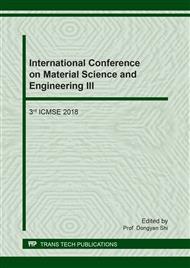[1]
M. El. Zayat, & E. Smith, Removal of Heavy Metals by Using Activated Carbon Produced from Cotton Stalks. Environmental Engineering Program, the American University in Cairo, (2006), p.1–9.
Google Scholar
[2]
M. M. Roa, D. H. K. K. Reddy, P. Venkateswarlu and K. Seshaiah, Removal of Mercury from aqueous solutions using activated carbon prepared from agricultural by-product/waste. J. Envir. Manag. 90(1) (2009) 634–643.
DOI: 10.1016/j.jenvman.2007.12.019
Google Scholar
[3]
S. Babel, & T. A. Kurniawan, Low-cost adsorbents for heavy metals uptake from contaminated water: a review. J. Hazard. Mater. 97(1-3) (2003) 219-243.
DOI: 10.1016/s0304-3894(02)00263-7
Google Scholar
[4]
R. Wahi, Z. Ngaini, & V. U. Jok, Removal of mercury, lead and copper from aqueous solution by activated carbon of palm oil empty fruit bunch. World Appl. Sci. J. 5 (2009) 84-91.
Google Scholar
[5]
H. Marsh, F. R. & Reinoso, Activated carbon. Elsevier, (2006).
Google Scholar
[6]
R. Ansari, Activated Charcoal : Preparation, characterization and Applications : A review article, 1(4) (2009) 859–864.
Google Scholar
[7]
H. A. Hegazi, Removal of heavy metals from wastewater using agricultural and industrial wastes as adsorbents. HBRC J. 9(3) (2013) 276–282.
DOI: 10.1016/j.hbrcj.2013.08.004
Google Scholar
[8]
K. Y. Foo, & B. H. Hameed, Insight into the modelling of adsorption isotherm system. Chem. Eng. J., 156(1) (2010) 2–10.
Google Scholar
[9]
E. Schröder, K. Thomauske, C. Weber, A. Hornung, & V. Tumiatti, Experiments on the generation of activated carbon from biomass. J. Anal. Appl. Pyrol. 79(1–2) (2007) 106–111.
DOI: 10.1016/j.jaap.2006.10.015
Google Scholar
[10]
O. Ioannidou, & A. Zabaniotou, Agricultural residues as precursors for activated carbon production—a review. Renew. Sustain. Energ. Rev. 11(9) (2007) 1966-(2005).
DOI: 10.1016/j.rser.2006.03.013
Google Scholar
[11]
E. Schröder, K. Thomauske, B. Oechsler, & S. Herberger, Activated carbon from waste biomass. In Progress in biomass and bioenergy production. InTech (2011).
DOI: 10.5772/20594
Google Scholar
[12]
T. Tay, S. Ucar, & S. Karagöz, Preparation and characterization of activated carbon from waste biomass. J. Hazard. Mater. 165(1-3) (2009) 481-485.
DOI: 10.1016/j.jhazmat.2008.10.011
Google Scholar
[13]
K. Kadirvelu, M. Kavipriya, C. Karthika, M. Radhika, N. Vennilamani, & S. Pattabhi, Utilization of various agricultural wastes for activated carbon preparation and application for the removal of dyes and metal ions from aqueous solutions. Biores. Tech. 87(1) (2003).
DOI: 10.1016/s0960-8524(02)00201-8
Google Scholar
[14]
M. Ulfah, S. Raharjo, P. Hastuti, & P. Darmadji, Adsorption of β-Carotene In Isopropyl Alcohol with Decolorized Activated Charcoal as Model for β-Carotene Adsorption in Crude Palm Oil. Indonesian J. Chem. 17(1) (2017) 105-112.
DOI: 10.22146/ijc.23637
Google Scholar
[15]
A. R. Hidayu, & N. Muda, Impregnated palm kernel shell activated carbon for CO2 adsorption by pressure swing adsorption. Indian J. Sci. Tech. 10(2) (2017).
DOI: 10.17485/ijst/2017/v10i2/110377
Google Scholar
[16]
S. Montoya-Suarez, F. Colpas-Castillo, E. Meza-Fuentes, J. Rodríguez-Ruiz, & R. Fernandez-Maestre, Activated carbons from waste of oil-palm kernel shells, sawdust and tannery leather scraps and application to chromium (VI) phenol, and methylene blue dye adsorption. Water Science and Technology, wst2015293, (2015).
DOI: 10.2166/wst.2015.293
Google Scholar
[17]
B. K. Hamad, A. M. Noor, A. R. Afida, & M. M. Asri, High removal of 4-chloroguaiacol by high surface area of oil palm shell-activated carbon activated with NaOH from aqueous solution. Desalinat. 257(1-3) (2010) 1-7.
DOI: 10.1016/j.desal.2010.03.007
Google Scholar
[18]
Q. Jia, & A. C. Lua, Effects of pyrolysis conditions on the physical characteristics of oil-palm-shell activated carbons used in aqueous phase phenol adsorption. J. Anal. Appl. Pyrol. 83(2) (2008) 175-179.
DOI: 10.1016/j.jaap.2008.08.001
Google Scholar
[19]
Y. B. Onundi, A. A. Mamun, M. F. Al Khatib, & Y. M. Ahmed, Adsorption of copper, nickel and lead ions from synthetic semiconductor industrial wastewater by palm shell activated carbon. Int. J. Envir. Sci. Tech. 7(4) (2010) 751-758.
DOI: 10.1007/bf03326184
Google Scholar
[20]
S. Sumathi, S. P. Chai, and A. R. Mohamed, Utilization of oil palm as sources of renewable energy in Malaysia. Renew. Sustain. Energ. Rev. 12(9) (2008) 2404-2421.
DOI: 10.1016/j.rser.2007.06.006
Google Scholar
[21]
Z. Zawani, A. L. Chuah, & T. Choong, Equilibrium, kinetics and thermodynamic studies: adsorption of Remazol Black 5 on the palm kernel shell activated carbon. European J. Sci. Res. 37(1) (2009) 67-76.
Google Scholar
[22]
M. M. Sanagi, Recent advanced in the preparation of palm oil waste-based adsorbent for removal of environmental pollutants-A review. Malaysian J. Anal. Sci. 22(2) (2018) 175-184.
Google Scholar
[23]
A. O. Dada, A. P. Olalekan, A. M. Olatunya, & O. Dada, Langmuir, Freundlich, Temkin and Dubinin–Radushkevich isotherms studies of equilibrium sorption of Zn2+ unto phosphoric acid modified rice husk. IOSR J. Appl. Chem. 3(1) (2012) 38-45.
DOI: 10.9790/5736-0313845
Google Scholar
[24]
Y. S. Ho, Citation revies of Lagergren kinetic rate equation on adsorption reactions. Scientometr. 59(1) (2004) 171– 177.
DOI: 10.1023/b:scie.0000013305.99473.cf
Google Scholar
[25]
M. Zabihi, A. Haghighi Asl, A. Ahmadpour, Studies on adsorption of mercury from aqueous solution on activated carbons prepared from walnut shell. J. Hazard. Mater. 174 (2010) 251–256.
DOI: 10.1016/j.jhazmat.2009.09.044
Google Scholar


